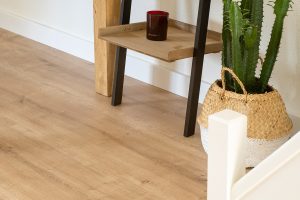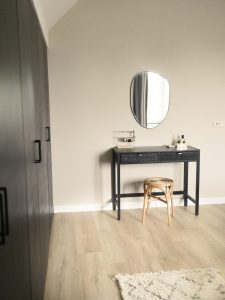 Flooring is a topic we often discuss, particularly the differences between different types. We have previously explained the differences between Laminate and Vinyl flooring, as well as the difference between Rigid Click Vinyl and Dryback Vinyl in detail. In this FloerTube video, we compare Click Laminate and Rigid Click Vinyl DIY floors side by side and discuss their differences. We take you into the world of the differences between Rigid Click Vinyl and Laminate flooring. Watch the video to find out more!
Flooring is a topic we often discuss, particularly the differences between different types. We have previously explained the differences between Laminate and Vinyl flooring, as well as the difference between Rigid Click Vinyl and Dryback Vinyl in detail. In this FloerTube video, we compare Click Laminate and Rigid Click Vinyl DIY floors side by side and discuss their differences. We take you into the world of the differences between Rigid Click Vinyl and Laminate flooring. Watch the video to find out more!
Difference 1: Laminate vs Vinyl
The primary difference between Click Laminate and Rigid Click Vinyl flooring lies in the materials used to create them. Laminate is a wood product made of compressed wood fibers (HDF), which are pressed hard onto a baseboard to create a strong plank. The abbreviation HDF stands for High-Density Fibreboard. Rigid Click Vinyl, on the other hand, is a mix of various materials. It has a plastic vinyl strip, which makes it similar to Dryback Vinyl flooring. Additionally, a combination of stone minerals is added to create a strong, durable product. Hence, we refer to the Rigid Click Vinyl flooring range as the rigid click mineral vinyl. The stone mineral interlayer gives Rigid Click Vinyl similar properties to those of Dryback Vinyl and Laminate.
Difference 2: Installation of the floor
Laminate flooring is known for its user-friendliness due to the easy-click connection between the floorboards. This makes it possible for any DIY enthusiast to lay laminate flooring themselves. For those inexperienced with DIY, we have helpful how-to videos available. This means you don’t need any prior experience to lay your favourite floor yourself! And the good news doesn’t stop there. Basically, the same applies to Rigid Click Vinyl floors! However, Rigid Click Vinyl is made of a heavier material than Laminate due to its rigid core. You will therefore need a bit of muscle to lay a Rigid Click Vinyl floor, and it is often experienced as less flexible compared to a lighter Laminate plank. To ensure a secure click-connection, we recommend using a rubber mallet to tap the floor when laying Rigid Click Vinyl.

Difference 3: Water on the Floer
We have discussed this before, but it’s worth mentioning again: one of the key differences between our flooring options is water resistance. Our Floer Laminate flooring can handle splashing water in a kitchen without issue, and we offer several collections with water-resistant coatings that can withstand up to 4 hours of puddling. However, no laminate flooring is 100% water-resistant, so we do not recommend it for use in bathrooms.
If you’re looking for a completely water-resistant option, we recommend our Rigid Click Vinyl flooring. It can be installed in a bathroom, but it’s important to properly install and seal it around the floor to ensure the entire surface is waterproof. We also offer other water-resistant flooring options, like extra wide laminate and oak laminate floors.
Difference 4: Thermal resistance
Who doesn’t love warm feet? Underfloor heating and floors are a golden combination. Do you have underfloor heating in your home? Always check with the supplier for the thermal resistance requirement of the underfloor heating system. We use 0.15 m2 K/W as the maximum thermal resistance because it is a common value. Both Rigid Click Vinyl floors and Laminate floors have thermal resistances well below this value and are therefore very suitable in combination with underfloor heating! There is a slight difference, though. Compared to Rigid Click Vinyl, laminate is a slightly poorer heat conductor. However, this does not necessarily mean it is less efficient. Thermal resistance indicates how quickly a floor gives off heat. If you crank up the heating and have a laminate floor, you will notice the warmth a few minutes later than if you had chosen a Rigid Click Vinyl floor.

Laminate floors with a thickness of 8 mm have a thermal resistance of 0.07 m2 K/W. The thermal resistance of Herringbone Laminate is slightly higher due to its increased thickness, with this collection having a thermal resistance of 0.09 m2 K/W. The Rigid Click Vinyl range, however, has a lower thermal resistance of 0.039 m2 K/W.
Floer tip
Remember that click floors must be laid on a subfloor that is suitable for underfloor heating. To ensure compatibility, add the thermal resistance of the subfloor to the thermal resistance of the click laminate or rigid click vinyl floor. Together, the total thermal resistance must be under the maximum thermal resistance of the underfloor heating installation, which is 0.15 m2 K/W. If the combination meets this requirement, the floor and underlay can be used with underfloor heating.
Difference 5: The types of underlays
Both laminate and rigid click vinyl floors require suitable underlays. However, there is a difference between the two. When it comes to laminate, you have more options for types of underlay. You can choose the Silent Underlay with a 10 dB certificate, use the Non-Contact Underlay, or stack Green Underlay Slabs under the laminate. On the other hand, there are fewer options for rigid click vinyl flooring due to the weight of the floorboards. These floors require a subfloor that offers sufficient support and compressive strength, also known as the kPa value. The higher the kPa value, the higher the pressure resistance of the subfloor, which provides better protection for heavy floorboards and click-connections.

For a rigid click vinyl floor, a subfloor with a high kPa value is necessary. We recommend a minimum kPa value of 200, but a higher value is preferred. Therefore, we strongly suggest using the Rigid Click Vinyl Underlay, which has a kPa value of 400 – double the minimum requirement. This underlay is essential to receive a 20-year guarantee on your favourite rigid click vinyl floor.
Did you know that there is a minimum kPa requirement for laminate flooring? This is often overlooked. For laminate, only 10 kPa is required, as opposed to 200 kPa for rigid click vinyl.
It’s back on! Here are the five major differences between click laminate and rigid click vinyl flooring. If you’re curious about more FloerTube videos, watch all episodes on the Floer YouTube channel and subscribe to stay up to date! If you want to read more, check out the Floer blog and learn all about flooring.






